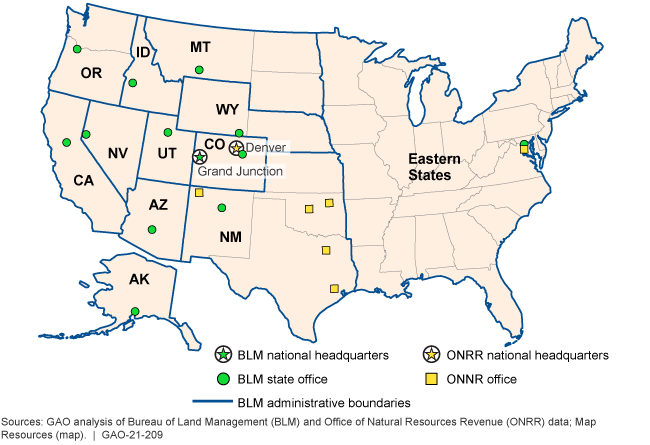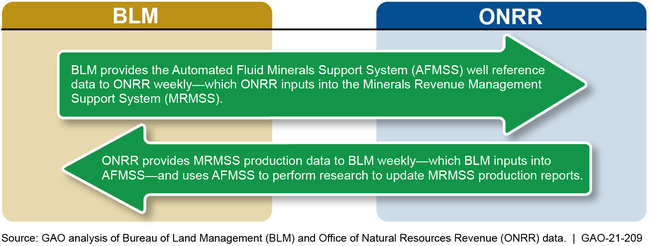Oil and Gas: Interior Should Strengthen Management of Key Data Systems Used to Oversee Development on Federal Lands
Fast Facts
Agencies within the Department of the Interior use 3 data systems to oversee oil and gas development on leased federal lands. The data systems process permits for drilling wells, among other things.
The systems are aging and create oversight challenges for the department. For example, they don't fully connect or communicate with each other. As a result, one agency uses more than 22,000 staff hours per year to reconcile data among the systems—the equivalent of about 10 full-time employees.
Interior is developing replacement data systems, but has not finalized a plan to share data across them. We recommended that Interior develop a plan to do so.
Staff using these data systems are spread across Bureau of Land Management and Office of Natural Resources Revenue offices nationwide.

Highlights
What GAO Found
The Department of the Interior (Interior) uses three key data systems to oversee oil and gas development on leased federal lands: the Automated Fluid Minerals Support System (AFMSS), Legacy Rehost 2000 (LR2000), and the Minerals Revenue Management Support System. Interior's Bureau of Land Management (BLM) and Office of Natural Resources Revenue (ONRR) staff rely on data across these systems to carry out responsibilities such as processing permits for drilling wells and ensuring appropriate payments are made based on production.
According to agency documents and officials, limited automated sharing of data among these systems is one of four challenges. Although the systems use some of the same information, such as lease and well numbers, they do not fully connect or communicate with each other, complicating oversight. For example, GAO calculated, based on agency estimates, that ONRR spends the equivalent of approximately 10 full-time employees in staff hours every year on conversion and error correction due to fragmented systems. Best practices call for coordinating and sharing data assets across federal agencies. Though Interior is developing replacement data systems, it does not have a finalized plan to facilitate comprehensive data sharing among them. Without such a plan, Interior risks continuing to spend staff time that could be better spent on other priorities.
Example of Oil and Gas Data Shared between BLM and ONRR Data Systems

Interior has not fully implemented leading practices in developing requirements to ensure the replacement systems meet user needs. Such practices have been found to improve development of federal data systems. BLM officials said they are developing replacement systems using an agile software development approach, which builds software incrementally based on users' requirements and continuously evaluates functionality, quality, and customer satisfaction. For example, BLM program offices responsible for developing systems to replace AFMSS and LR2000 stated that they meet quarterly with system stakeholders to prioritize and agree on features and functionality. However, the program offices do not have a defined process to implement the agile approach because it is not addressed in Interior's guidance on data system development. By updating the guidance to reflect how program offices can implement an agile development approach, Interior would have better assurance that its new data systems will function as intended to meet user needs and reduce budget and schedule risks.
Why GAO Did This Study
Development of oil and gas resources on federal lands helps supply the U.S. with energy and generates billions of dollars annually in revenues. To oversee this development, Interior relies on aging data systems, which it is planning to replace.
GAO was asked to review the data systems Interior uses to oversee oil and gas development on federal lands and waters. This report (1) describes how Interior uses key data systems to oversee oil and gas development on federal lands, (2) examines challenges Interior faces in using these systems, and (3) evaluates Interior's implementation of leading practices in developing requirements for replacement systems.
GAO reviewed documents, interviewed officials from federal and state agencies, visited BLM and ONRR offices in Colorado and New Mexico, and assessed Interior's implementation of relevant leading practices.
Recommendations
GAO is making six recommendations, including that Interior develop a plan to improve data sharing among its key data systems and that Interior update its guidance for developing new data systems to address how program offices are to implement agile development.
Interior concurred with GAO's recommendations.
Recommendations for Executive Action
| Agency Affected | Recommendation | Status |
|---|---|---|
| Bureau of Land Management | The Director of BLM should consistently designate data stewards at relevant levels to ensure data are of known and sufficient quality. (Recommendation 1) |
To implement this recommendation, in December 2022, BLM issued Instruction Bulletin No. OC-2023-003, Published BLM National Data Sets and Associated Data Stewards. The bulletin transmitted BLM's current list of published national data sets and associated data stewards, meeting the intent of our recommendation. The links included for each data set entry provide real time access to the data source, including information about the programs or individuals responsible for them.
|
| Department of the Interior |
Priority Rec.
The Secretary of the Interior should direct the Chief Information Officer to develop a plan to address data-sharing challenges in the course of updating and modernizing key oil and gas data systems, including automating data sharing and adopting common identifiers for leases and operators. (Recommendation 2) |
Interior agreed with this recommendation and has taken several steps to address it. In particular, the Office of the Chief Information Office issued a new Data Sharing Policy on May 8, 2023, that establishes mandatory data sharing requirements and responsibilities. The policy requires that all new systems or those undergoing modernization must provide automated data sharing capabilities, establish a timeline for systems to have complete data dictionaries in place, and requires bureaus and offices to use common standards wherever possible. These steps meet the intent of our recommendation, and better ensure Interior will address its data-sharing challenges going forward.
|
| Bureau of Land Management | The Director of BLM should develop training plans for key data systems that identify users and how they will be trained. (Recommendation 3) |
BLM completed a training plan for one of the two systems reviewed in our report. Specifically, in January 2024, BLM completed a training plan for its Mineral and Land Records System that identifies users and how they will be trained. However, as of August 2025, BLM had not developed a training plan for its Automated Fluid Mineral Support System, and BLM officials stated that the agency has not set a timeframe for completing a training plan. We continue to monitor actions to address this recommendation.
|
| Department of the Interior | The Secretary of the Interior should direct the Chief Information Officer to develop a process to ensure that program offices maintain requirementsrelated documentation supporting the development and management of requirements for future IT and data systems at BLM and ONRR. (Recommendation 4) |
To implement this recommendation, in July 2022, Interior issued a memorandum to bureaus and offices that established the Information Technology Portfolio Management Policy. The policy instructs bureaus and offices to establish and maintain a full system life cycle process that applies to the acquisition, development, maintenance, enhancement, operation, and disposal of IT systems and solutions. Additionally, the bureaus and offices must collect and maintain data and artifacts for all IT investments commensurate with IT portfolio management processes and IT capital planning guidance, and submit an annual certification statement to ensure adherence. As a result of this policy, Interior will have a process in place to ensure that program offices have an increased understanding of the capabilities of future IT and data systems and establish a basis for those requirements.
|
| Bureau of Land Management | The Director of BLM should define and document processes for developing and managing requirements for AFMSS II and MLRS in a manner consistent with existing or updated IT policies and guidance. (Recommendation 5) |
In May 2021, we found that BLM did not have defined processes for managing requirements as they developed these two data systems and recommended the agency define and document these processes. In May 2022, BLM issued guidance reiterating that its 2016 Capital Planning and Investment Control handbook should be used, and considered the recommendation addressed as a result. While the 2016 policy provided a broad framework for requirements, it did not specify in any detail BLM's expectations for how requirements are to be developed and managed for AFMSS II and MLRS. For example, our report highlighted a lack of definition regarding which stakeholders should be involved in providing input and at what stages when developing customer requirements. The 2016 handbook did not address such issues. BLM subsequently concluded development of these two data systems without implementing our recommendation. Since BLM is no longer developing these two data systems and therefore has no need for defined requirements management processes for the systems, we are closing this recommendation as no longer valid.
|
| Department of the Interior | The Secretary of the Interior should direct the Chief Information Officer to update Interior's Solution Development Lifecycle Guide or other relevant IT policies and guidance to address how program offices are to implement agile methodologies for the development of software. (Recommendation 6) |
Interior concurred with this recommendation. Instead of updating departmentwide policies to address agile methodologies, in July 2022 the Office of the Chief Information Officer issued a new policy that directs individual bureaus and offices to "establish and maintain a full system life cycle process." Though Interior considers this action to have addressed our recommendation, the new policy does not define how program offices are to implement agile methodologies. To address this recommendation, Interior should take steps to ensure departmentwide policies or individual bureau and office policies address how programs are to implement agile methodologies. As of May 2025, we continue to monitor actions to address this recommendation.
|
